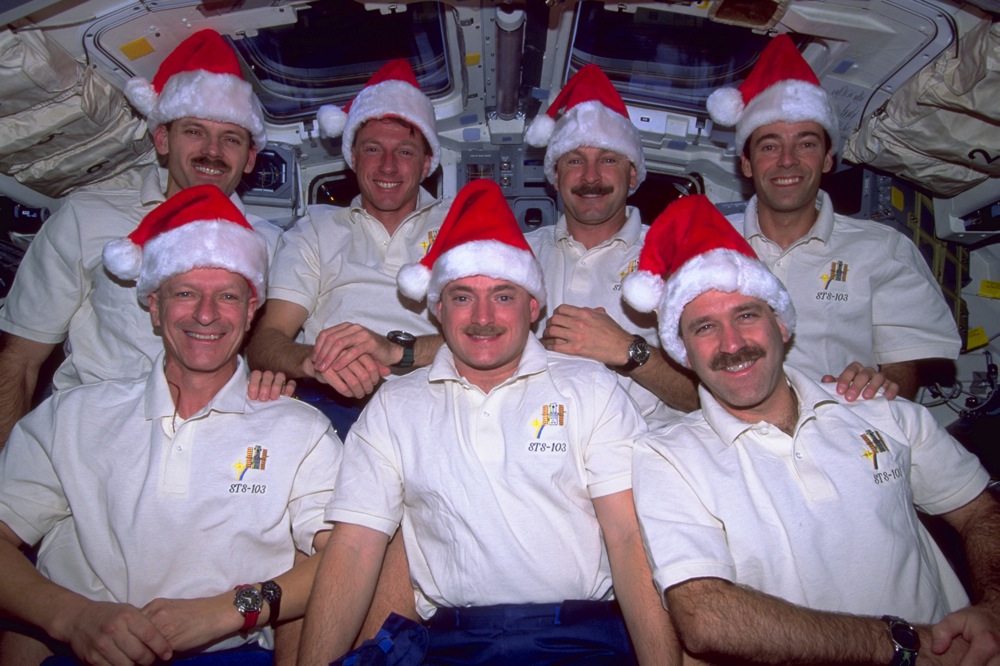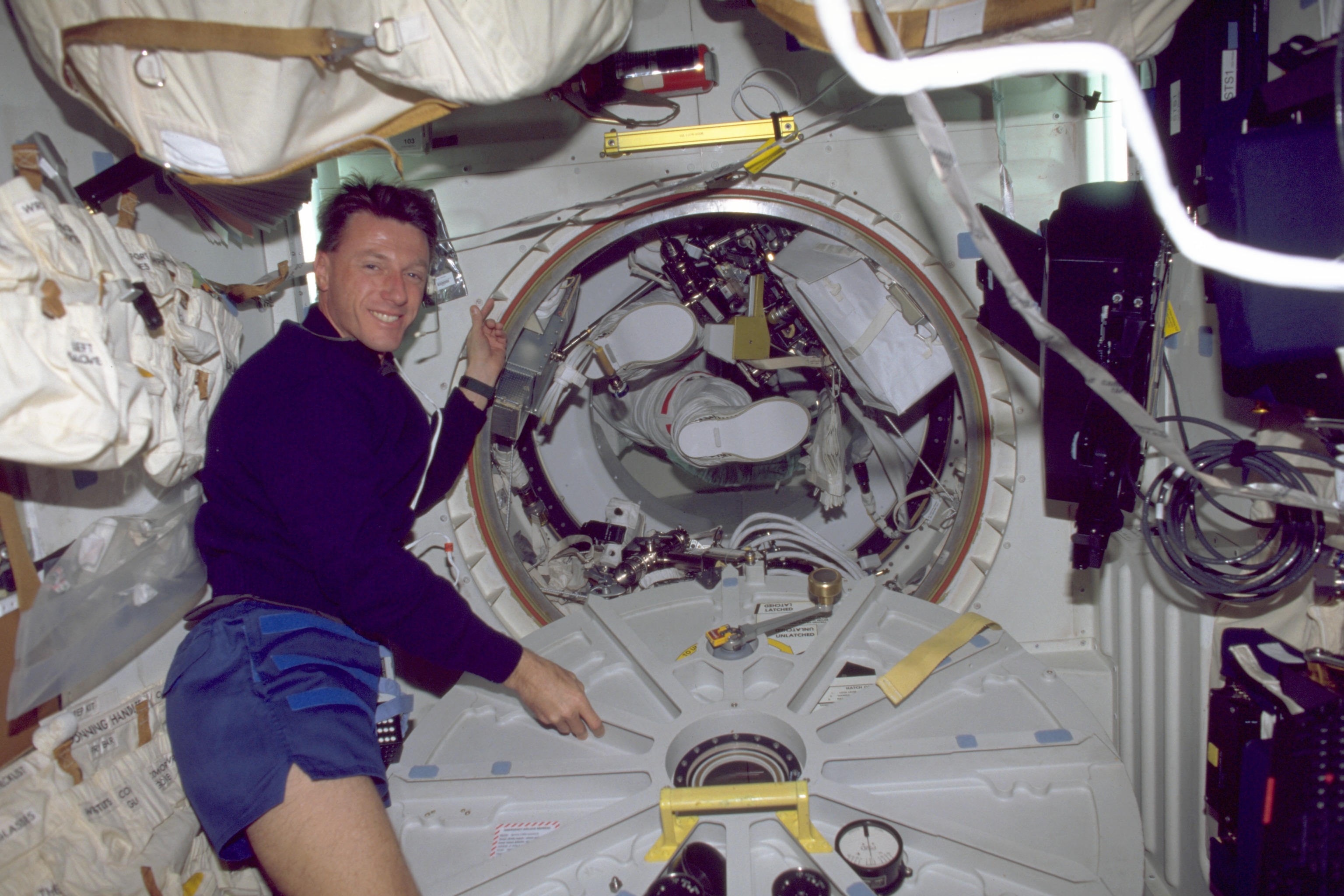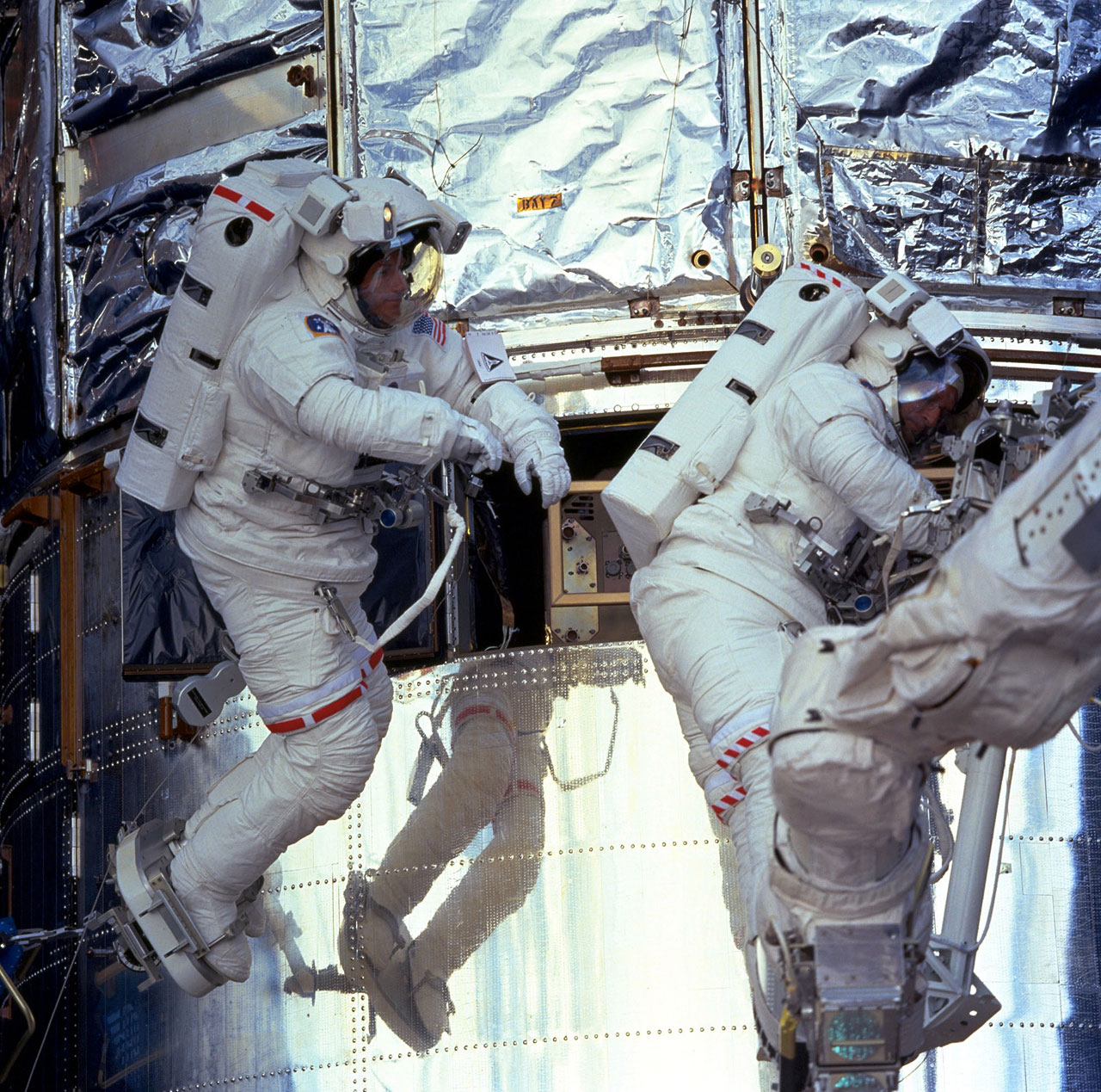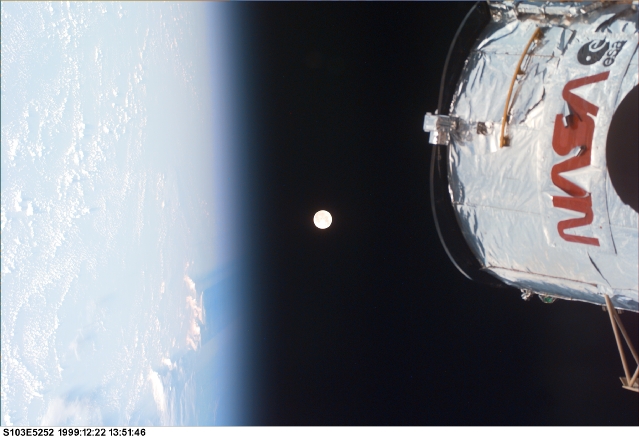Picture of Santa: Remembering Discovery's Date With Hubble, 20 Years On (Part 2)By Ben Evans, on December 30th, 2019
 The STS-103 astronauts were the only Space Shuttle crew to celebrate Christmas in orbit, way back in 1999. Photo Credit: NASATwenty years ago, seven astronauts spent Christmas Day in space, peering from the windows of shuttle Discovery. STS-103 in December 1999 marked the only occasion in the shuttle program’s three decades of service that a mission took place entirely over the festive period. As outlined in last weekend’s AmericaSpace history article, a yuletide flight in the final days before the new millennium was not the original plan, but technical woes with the shuttle fleet and with the Hubble Space Telescope (HST)—Discovery’s primary objective—during the course of 1999 had pushed STS-103 into high priority.
The STS-103 astronauts were the only Space Shuttle crew to celebrate Christmas in orbit, way back in 1999. Photo Credit: NASATwenty years ago, seven astronauts spent Christmas Day in space, peering from the windows of shuttle Discovery. STS-103 in December 1999 marked the only occasion in the shuttle program’s three decades of service that a mission took place entirely over the festive period. As outlined in last weekend’s AmericaSpace history article, a yuletide flight in the final days before the new millennium was not the original plan, but technical woes with the shuttle fleet and with the Hubble Space Telescope (HST)—Discovery’s primary objective—during the course of 1999 had pushed STS-103 into high priority.
The long-serving scientific showpiece had begun to falter in March 1999, when the third of its six gyroscopes failed, putting it at the barebones minimum capacity necessary to achieve astronomical pointing. A shuttle servicing mission was already planned for June 2000, but NASA decided to bring the STS-103 launch date forward to October 1999 to tend to the most urgent repairs. But another shuttle launch in July of that year suffered a short circuit soon after liftoff, which knocked out two main engine controllers and almost forced an emergency landing. The fleet was grounded for extensive wiring inspections and after several additional technical challenges Discovery finally set off on 19 December.
By this time, and with much hype over the “Y2K” computer bug, STS-103 had been shortened from ten to eight days and the number of scheduled Extravehicular Activities (EVAs) had been cut from four to three, to ensure that the shuttle was back on the ground before clocks turned over to the new millennium. Two days into the flight, Commander Curt Brown and Pilot Scott Kelly maneuvered their ship close to the school-bus-sized Hubble and French astronaut Jean-Francois Clervoy deftly grappled the telescope with the 50-foot-long (15-meter) Remote Manipulator System (RMS) robotic arm.  Mike Foale prepares to close the airlock hatch behind Steve Smith and John Grunsfeld, before one of STS-103’s EVAs. Photo Credit: NASAIt was then the task of STS-103’s four spacewalkers—Steve Smith, John Grunsfeld, Mike Foale and Swiss astronaut Claude Nicollier—to kick off the three EVAs. On 22 December, Smith and Grunsfeld spent eight hours and 15 minutes outside, performing the second-longest spacewalk in shuttle history at that time. The duo replaced all six aging gyroscopes and installed battery voltage regulator kits to keep Hubble’s batteries properly conditioned. They then opened a pair of valves to vent residual nitrogen from the Near-Infrared Camera and Multi-Object Spectrometer (NICMOS), which had suffered a thermal short and been out of action since January 1999 due to dwindling coolant supplies. A new gaseous neon cooling system was set to installed by another shuttle crew to bring NICMOS back to life.
Mike Foale prepares to close the airlock hatch behind Steve Smith and John Grunsfeld, before one of STS-103’s EVAs. Photo Credit: NASAIt was then the task of STS-103’s four spacewalkers—Steve Smith, John Grunsfeld, Mike Foale and Swiss astronaut Claude Nicollier—to kick off the three EVAs. On 22 December, Smith and Grunsfeld spent eight hours and 15 minutes outside, performing the second-longest spacewalk in shuttle history at that time. The duo replaced all six aging gyroscopes and installed battery voltage regulator kits to keep Hubble’s batteries properly conditioned. They then opened a pair of valves to vent residual nitrogen from the Near-Infrared Camera and Multi-Object Spectrometer (NICMOS), which had suffered a thermal short and been out of action since January 1999 due to dwindling coolant supplies. A new gaseous neon cooling system was set to installed by another shuttle crew to bring NICMOS back to life.
When an exhausted Smith and Grunsfeld returned inside Discovery, there was jubilation, for replacing the six gyroscopes constituted the completion of 80 percent of STS-103’s most critical tasks. Astronauts Michael Foale and Claude Nicollier perform an EVA during the STS-103 mission, Hubble Servicing Mission 3A. Photo Credit: NASANext day, Foale and Nicollier were outside for eight hours and ten minutes, the major focus of which was installing a new computer with radiation-hardened Intel 486 processor into the telescope. This would replace Hubble’s vintage 1970s-era technology. The chair-sized computer was 20 times faster and carried six times greater memory than its predecessor, whilst running on only a third of the electrical power.
Astronauts Michael Foale and Claude Nicollier perform an EVA during the STS-103 mission, Hubble Servicing Mission 3A. Photo Credit: NASANext day, Foale and Nicollier were outside for eight hours and ten minutes, the major focus of which was installing a new computer with radiation-hardened Intel 486 processor into the telescope. This would replace Hubble’s vintage 1970s-era technology. The chair-sized computer was 20 times faster and carried six times greater memory than its predecessor, whilst running on only a third of the electrical power.
However, it was a tricky task, requiring Foale to feel around for hard-to-see connectors on the left side of the computer box. He also had to take great care not to hit connectors on a nearby data-management unit. Nicollier provided visual cues for Foale and in relatively short order the new computer was installed. “Most excellent,” radioed Grunsfeld from Discovery’s cabin. “Hubble’s brains have been replaced.” The spacewalkers then installed a fine guidance sensor, which had been plucked out of Hubble on the previous servicing mission in 1997 and returned to Earth for refurbishment. After some trouble aligning it properly, the sensor was fitted and ready for a rejuvenated second life in orbit. Spectacular view of the top of the Hubble Space Telescope, the limb of Earth and a full Moon, as captured by one of the STS-103 astronauts. Photo Credit: NASANext day, Smith and Grunsfeld ventured outside for the first U.S. spacewalk ever performed on Christmas Eve. For the next eight hours and eight minutes, they labored to replace an engineering science tape recorder with a new solid-state recorder and a new S-band Single Access Transmitter to replace a similar unit which had failed. The transmitter assisted with data transfer through NASA’s Tracking and Data Relay Satellite (TDRS) network and was never intended for orbital replacement, requiring the spacewalkers to handle many fiddly screws and cable connectors. This put them rapidly behind schedule and Grunsfeld likened the problem to fixing a watch whilst wearing winter gloves. When they finally declared success and returned inside Discovery, STS-103’s EVA tally ran to over 24 hours of spacewalking over three days.
Spectacular view of the top of the Hubble Space Telescope, the limb of Earth and a full Moon, as captured by one of the STS-103 astronauts. Photo Credit: NASANext day, Smith and Grunsfeld ventured outside for the first U.S. spacewalk ever performed on Christmas Eve. For the next eight hours and eight minutes, they labored to replace an engineering science tape recorder with a new solid-state recorder and a new S-band Single Access Transmitter to replace a similar unit which had failed. The transmitter assisted with data transfer through NASA’s Tracking and Data Relay Satellite (TDRS) network and was never intended for orbital replacement, requiring the spacewalkers to handle many fiddly screws and cable connectors. This put them rapidly behind schedule and Grunsfeld likened the problem to fixing a watch whilst wearing winter gloves. When they finally declared success and returned inside Discovery, STS-103’s EVA tally ran to over 24 hours of spacewalking over three days.
Nor was the work of the astronauts inside the shuttle any less taxing. Clervoy was required to operate the RMS arm for many hours of concentrated focus, backed up by either Grunsfeld or Nicollier. The crew deployed Hubble perfectly back into space as Christmas arrived and the only shuttle crew ever to spend the festive day in space tucked into a dinner of duck liver and other delicacies from southwest France, provided by Clervoy. Later that afternoon, NASA Administrator Dan Goldin congratulated the astronauts on their accomplishments and Brown expressed fervent hope that, just as Hubble had done, humanity would continue to search “for a deeper understanding of life and for greater wisdom”.
Discovery returned smoothly to Earth on 27 December, wrapping up almost eight days in space. Standing on the runway, there was time for a few philosophical words. Foale stressed that at the dawn of the 20th century even powered flight remained a dream, much less the fallacy of leaving the planet and traveling into space. And for Kelly, who closed out his first spaceflight on STS-103, a strong family thread ran through the mission. Before launch, he had struggled to explain to his young daughter that he could not be with her on Christmas morning. But Kelly did have one promise for her. He would, he pledged, turn Hubble towards the North Pole and snap a picture of Santa, just for her.Source:
https://www.americaspace.com/2019/12/30/picture-of-santa-remembering-discoverys-date-with-hubble-20-years-on-part-2/